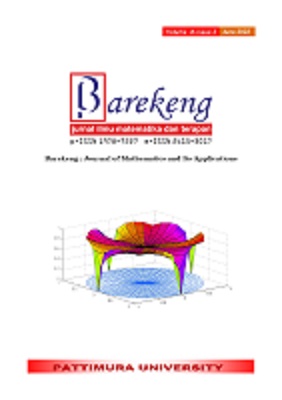THE APPLICATION OF MUSICAL INTELLIGENCE-BASED MATHEMATICS LEARNING ON PLANE SHAPE DISCUSSION
Abstract
In this study, Gardner's theory of multiple intelligences was used to conduct experimental research on several elementary school students at TPQ Al-Ikhwan Meruya Jakarta, Indonesia. The initial stage of this study was to classify the types of student intelligence using multiple intelligence instruments adopted from Shearer in 1997. Furthermore, learning strategies are applied to students according to the kind of intelligence. This study observed the differences in mathematics learning outcomes of students who have musical intelligence before and after the application of interactive learning media in the form of music containing a song with the title "Aku Bangun Datar" and the lyrics are examples of a two-dimensional figure with natural objects. The research method used was a quantitative quasi-experimental type with a pre-test-post-test design. Research data analysis using a statistical t-test for the difference in the mean of the two populations. The results of data analysis obtained a t value of -8,000, while the t table is -2.0686. The comparison between the t value and the t table is known that t is more significant than the t table, so the hypothesis is rejected. It means that there is a significant difference in students' knowledge about shapes before and after using music media.
Downloads
References
C. D. Lamichhane, “Understanding the Education Philosophy and Its Implications,” NCC J., vol. 3, no. 1, pp. 24–29, 2018, doi: 10.3126/nccj.v3i1.20245.
C. M. Tyng, H. U. Amin, M. N. M. Saad, and A. S. Malik, “The influences of emotion on learning and memory,” Front. Psychol., vol. 8, no. AUG, 2017, doi: 10.3389/fpsyg.2017.01454.
N. Abdullah, L. Halim, and E. Zakaria, “VStops: A thinking strategy and visual representation approach in mathematical word problem solving toward enhancing STEM literacy,” Eurasia J. Math. Sci. Technol. Educ., vol. 10, no. 3, pp. 165–174, 2014, doi: 10.12973/eurasia.2014.1073a.
T. T. Wijaya, Z. Ying, L. Cunhua, and Zulfah, “Using Vba Learning Media To Improve Students’ Mathematical Understanding Ability,” J. Educ., vol. 02, no. 02, pp. 245–254, 2020, [Online]. Available: https://www.jonedu.org/index.php/joe/article/view/314
R. Ramadhani and S. D. Narpila, “Problem based learning method with geogebra in mathematical learning,” Int. J. Eng. Technol., vol. 7, no. 3.2 Special Issue 2, pp. 774–777, 2018, doi: 10.14419/ijet.v7i3.2.18753.
T. Tanu Wijaya, Z. Ying, S. Chotimah, M. Bernard, Zulfah, and Astuti, “Hawgent dynamic mathematic software as mathematics learning media for teaching quadratic functions,” J. Phys. Conf. Ser., vol. 1592, no. 1, 2020, doi: 10.1088/1742-6596/1592/1/012079.
Howard Gardner, “Multiple Intelligences: The Theory in Practice , Multiple Intelligences: New Horizons,” pp. 1–24, 1983.
A. Winarti, L. Yuanita, and M. Nur, “Journal of Technology and Science Education THE EFFECTIVENESS OF MULTIPLE INTELLIGENCES BASED INTELLIGENCES AND SCIENCE PROCESS SKILLS OF JUNIOR HIGH,” vol. 9, no. 2, pp. 122–135, 2019.
V. D. Abrahan, F. Shifres, and N. Justel, “Cognitive benefits from a musical activity in older adults,” Front. Psychol., vol. 10, no. MAR, p. 652, 2019, doi: 10.3389/FPSYG.2019.00652/BIBTEX.
Arielle S. Dolegui, “The Impact of Listening to Music on Cognitive Performance - Inquiries Journal,” Inquiries journal, 2013. http://www.inquiriesjournal.com/articles/1657/the-impact-of-listening-to-music-on-cognitive-performance (accessed May 11, 2022).
A. Chao-Fernández, D. Mato-Vázquez, and R. Chao-Fernández, “Influence of musical learning in the acquisition of mathematical skills in primary school,” Mathematics, vol. 8, no. 11, pp. 1–13, 2020, doi: 10.3390/math8112003.
S. Holmes and S. Hallam, “The impact of participation in music on learning mathematics,” London Rev. Educ., vol. 15, no. 3, pp. 425–438, 2017, doi: 10.18546/LRE.15.3.07.
A. Criscuolo, L. Bonetti, T. Särkämö, M. Kliuchko, and E. Brattico, “On the Association Between Musical Training, Intelligence and Executive Functions in Adulthood,” Front. Psychol., vol. 10, no. JULY, Jan. 2019, doi: 10.3389/FPSYG.2019.01704.
B. Geethanjali, K. Adalarasu, and R. Rajsekaran, “Impact of Music on Brain Function during Mental Task using Electroencephalography,” World Acad. Sci. …, vol. 6, no. 6, pp. 883–887, 2012, [Online]. Available: https://waset.org/journals/waset/v66/v66-164.pdf
E. Prima, “Pengaruh Ritme Otak dan Musik dalam Proses Belajar,” [The Effect of Brain Rhythm and Music in the Learning Process] KOMUNIKA J. Dakwah dan Komun., vol. 12, no. 1, pp. 43–57, Jun. 2018, doi: 10.24090/KOMUNIKA.V12I1.1351.
G. J. T. Garryn C. Ranuntu, “Peran lagu dalam pengajaran bahasa inggris tingkat dasar,” [The role of songs in teaching basic English] J. LPPM Bid. EkoSosBudKum, vol. 4, no. 1, pp. 99–110, 2018.
T. K. Aisyiyah et al., “Pengaruh Musik Instrumental Dalam Pembelajaran Terhadap Pemahaman Konsep Matematika Siswa,” [The Effect of Instrumental Music in Learning on Students' Understanding of Mathematical Concepts] pp. 1–9, 2016.
Authors who publish with this Journal agree to the following terms:
- Author retain copyright and grant the journal right of first publication with the work simultaneously licensed under a creative commons attribution license that allow others to share the work within an acknowledgement of the work’s authorship and initial publication of this journal.
- Authors are able to enter into separate, additional contractual arrangement for the non-exclusive distribution of the journal’s published version of the work (e.g. acknowledgement of its initial publication in this journal).
- Authors are permitted and encouraged to post their work online (e.g. in institutional repositories or on their websites) prior to and during the submission process, as it can lead to productive exchanges, as well as earlier and greater citation of published works.






1.gif)



